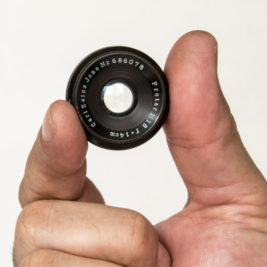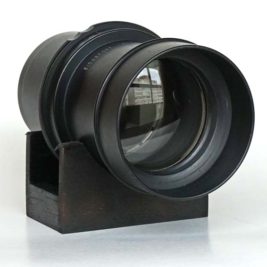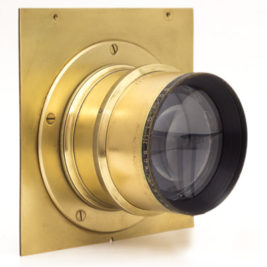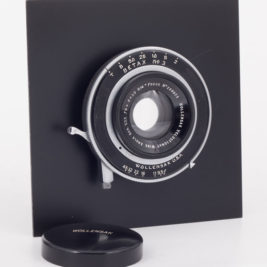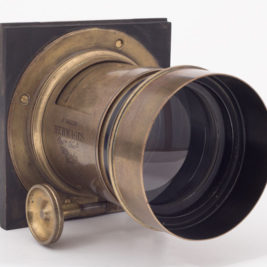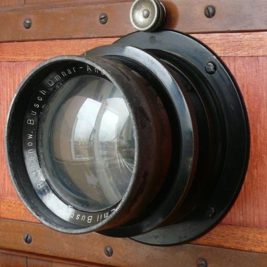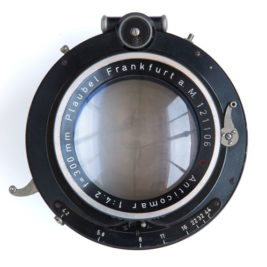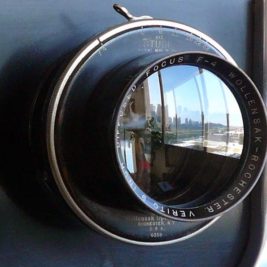Small lens whose design is among the first anastigmatics. The Collinnear, sometimes referred as Kollinnear, created by the Voigtländer firm in 1893, using the newly developed glasses in Jena was, among others of the same type, a step change in photographic optics.
lenses
Find here some interesting lenses present in my collection. I dedicated more attention to “big glasses”, that means, large format photography lenses, because that is where the most important designs made their contribution to the endeavour of transforming light into images.
Protar V – Anastigmat 1:18 | Carl Zeiss Jena
Lens from Carl Zeiss, designed in 1890/ These samples were produced in 1926/7. The Protar V is an super wide angle lens capable of excellent results although very small and light weight. A desirable optics for large format photography.
Zeiss Protar Convertible Anastigmat | Ross London
One of the first anastigmatic lens in the history of photography. Manufactured by Ross, in England, under license from the German Zeiss. It has 8 elements in two groups that can still be used individually offering thus three focal distances.
Eidoscope | SOM Berthiot
A lens originally developed by Hermagis and launched in 1903, the Eidoscope is one of the highlights of soft focus optics. This sample was manufactured later by SOM Berthiot, which kept Eidoscope in its catalog after acquiring Hermagis in 1934.
Tessar | Carl Zeiss Jena
– 360 mm | f:6,3 | 1911 – The very first Tessar Tessar is probably the lens design most produced ever. Introduced in 1902, it was created by Paul Rudolph, from Carl Zeiss. The construction concept has found applications from large format down to Minox size. Lenses using Tessar’s...
Velostigmat Wide Angle Ser. III f9.5 | Wollensak
Brief article discusses the design, characteristics and ancestry of Wollensak's Wide Angle Velostigmat lens and shows an image made with it on an 18 x 24 cm negative.
Objectif pour portrait Nº5 – Petzval design | Fleury-Hermagis
Lens description with photos, measurements and presence in a manufacturer's catalog. Photographs of pencil inscriptions on the edge of optical elements and details of the standard carte-album format, popular in the late nineteenth and early twentieth centuries, to which this lens was intended.
Omnar | Emil Busch
– 255 mm | f:4,5 | c1906 – This is an anastigmat general purpose lens produced by Emil Busch A.-G. Rathenow. It came with a wood camera that uses 13 x 18 cm film/plate. That allows a good range of front movements more than camera can deliver as the angle of view is 80º and correspondent image...
Heliar | Voigtlander
A cult lens, Heliar is famous for giving images a certain creaminess. For this reason, it is still used by many "fine art" photographers and disputed on websites and auction houses.
Anticomar | Plaubel
Anticomar is a somewhat controversial lens. Designed on the basis of a Tessar, it is able to bring many details and definition. However, in this version of Plaubel, it brings also a reasonable level of flare that creates a slight halo around bright objects.
Verito | Wollensak
Wollensak's soft focus lens, Verito has its most iconic images probably in pictures of Hollywood stars. Simple in construction and especially designed for studio portraits, it adds a halo that can go from very discreet to completely dominate the image.
Super-Angulon 90 f/5.6 | Schneider Kreuznach
One of the best wide-angle lenses ever made, Schneider's Super Angulon f / 5.6 has a slightly asymmetric optics and delivers perfect results with ease of use. Find here specs, photos of the lens and an urban picture taken with it.

